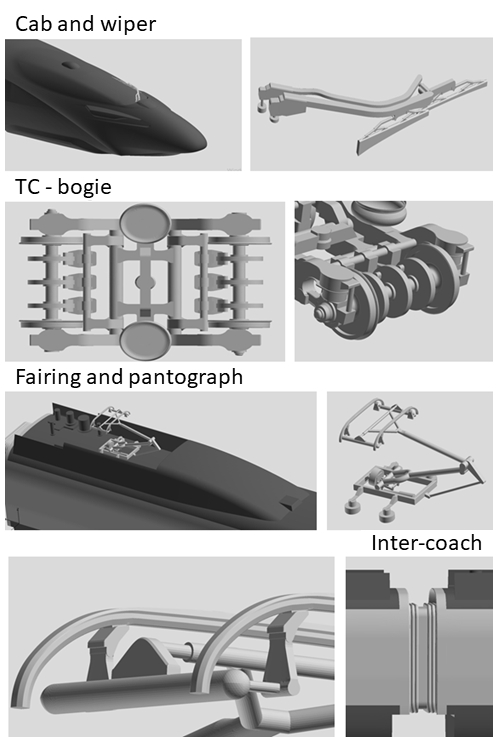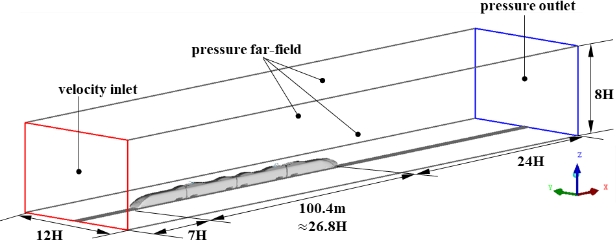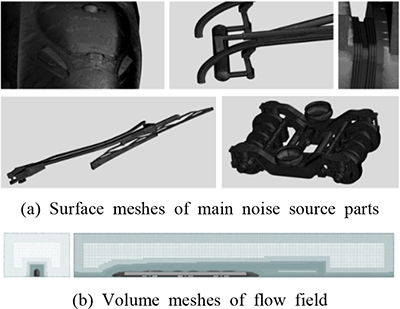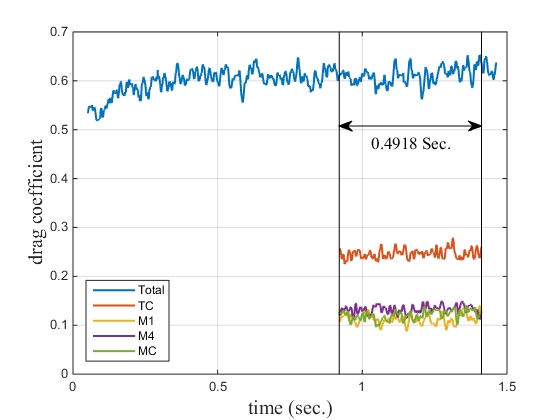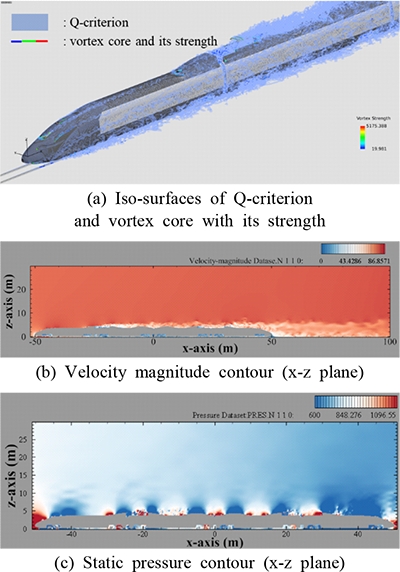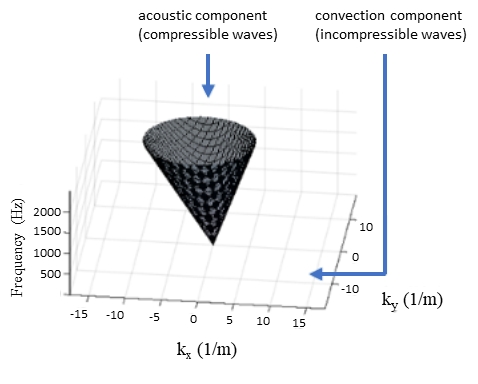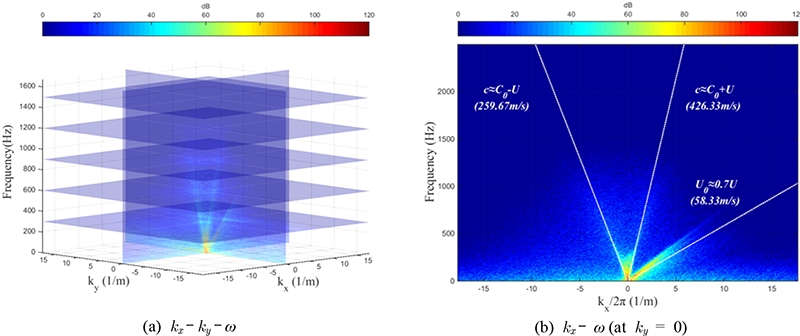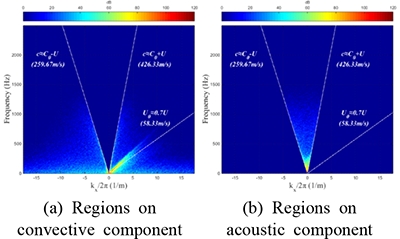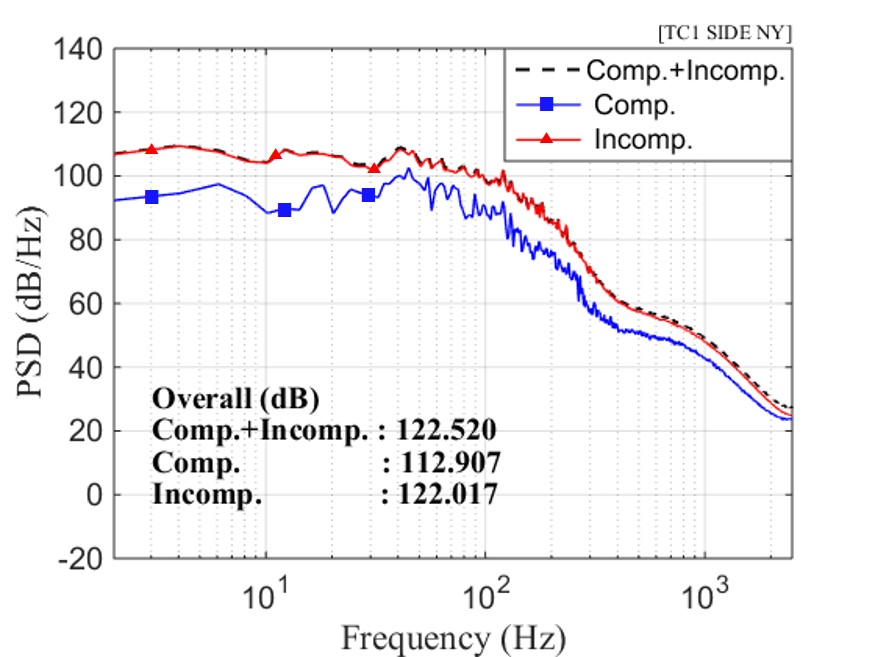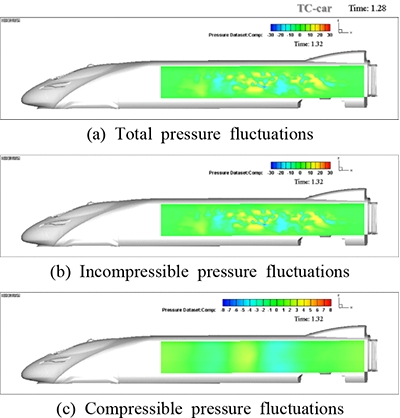
고속열차의 바람소리에 따른 실내소음 예측을 위한 표면압력 섭동의 파수-주파수 분석
© The Korean Society for Noise and Vibration Engineering
Abstract
Several contemporary studies have been carried on the challenge of predicting or reducing the exterior aerodynamic noise and interior noise induced by exterior air flow around high-speed trains. The achievement of reliable numerical prediction of noise in a passenger cabin due to exterior flow requires decomposition of the surface pressure fluctuations into hydrodynamic (incompressible) and the acoustic (compressible) fluctuation types, as well as the accurate computation of the near aeroacoustic field. This can be done because the transmission characteristics of each type of pressure wave through the cabin wall panels differ significantly. In this paper, wavenumber-frequency analysis is performed to accurately predict interior noise due to exterior aerodynamic noise from surface pressure fluctuations. First, large eddy simulation (LES) techniques were employed to predict the exterior flow field including an accurate near acoustic field around a high-speed train running at a speed of 300 km/h in an open field. Then, pressure fluctuations on the train surface were decomposed and categorized as incompressible/compressible, and power spectral density spectra were obtained using wavenumber-frequency analysis. Finally, the separated incompressible and compressible surface pressure fields in the time-space domain were obtained from the inverse Fourier transform of each incompressible/compressible wavenumber-frequency spectrum.
Keywords:
High-speed Train, HEMU-430X, Large Eddy Simulation, Flow Noise, Wavenumber-Frequency Analysis키워드:
고속열차, 해무, 큰 에디 모사, 유동소음, 파수-주파수 분석1. 서 론
고속철도는 20세기 후반에 등장하여 현재 주요 교통수단으로 자리매김하였다. 고속철도 선진국인 독일, 일본, 프랑스를 비롯하여 국내에서도 고속철도차량 국산화를 위한 기술 시험용 고속열차 HSR-350X, HEMU-430X의 개발과 상업용 고속열차 EMU260/320을 개발하는 등 기술우위를 점하기 위한 치열한 속도 경쟁을 벌이고 있다. 고속열차의 이름에서 알 수 있듯이 시험 열차의 최소 속도는 400 km/h을 넘기고 있으나 상업운전 속도는 약 300 km/h 수준이다. 이는 시험 열차의 개발단계와는 달리 상업운전에서는 안정성을 비롯하여 승객의 편의성 및 정숙성이 요구되기 때문이다(1). 차량에 따라 편차는 있지만 열차의 속도가 대략 250 km/h ~ 300 km/h을 넘어서면 휠/레일 접촉에 의한 구름소음보다 차체와 차체 주위를 지나는 유동의 상호작용에 의한 바람소음의 영향이 커지게 된다(2). 차체에서 발생하는 공력소음은 발생원인에 따라 풍절음, 흡출음, 공동소음 등 여러 요인들이 있다. 이 중 특히 풍절음의 경우 열차의 외부 구조물 중 필연적으로 돌출되어 있을 수밖에 없는 형상주위에서 발생하여 풍절음 자체의 저감에는 한계가 있다. 따라서 풍절음의 내부 전달을 최소화하기 위한 연구가 필수적이다.
자동차의 경우 독일의 자동차 연구조합을 중심으로 자동차 바람소리에 따른 내부 소음에 관한 실험적, 수치적 연구가 처음으로 시작되어(3), 국내에서도 현대자동차에서 단순화된 모형차(Hyundai simplified model)에 대하여 외부 바람소음의 실내전달음에 대한 맹검시험(blind test)을 수행하는 workshop(4)을 개최하는 등 바람소음의 내부전달에 관한 연구가 활발히 진행되고 있다. 하지만 고속열차의 경우 대상의 매우 큰 크기로 인해 연구에 큰 어려움이 있다. 고속열차 공력소음에 대한 몇몇 연구들이 발표되었지만 축소모형 및 주요 소음원이라 알려진 판토그라프(pantograph), 대차(bogie) 등 일부 대상만을 대상으로 한 실험적, 해석적 연구(2,5~8)가 주를 이루고 있다.
이 연구의 궁극적 목표는 고속열차의 바람소리에 따른 객실 내부소음의 정확한 예측을 위한 수치해석 방법론 개발이다. 이러한 경우 고속열차의 외부 유체를 가진원으로 구조물의 진동을 통하여 다시 열차 내부 유체로 전달되는 유체-구조-유체 이중 상호작용 문제이다. 구조물에서의 전파는 구조물 표면의 압력섭동 분포를 입력값으로 예측하게 된다. 이러한 압력섭동은 와류에 의하여 유체밀도의 섭동없이 직접 유도되는 유체역학적 압력인 비압축성 압력섭동과 음향파인 압축성 압력섭동이 혼재되어 있어 각각의 전파특성에 따라 분하여 접근해야 한다(9~12). 따라서 이 논문에서는 고속열차 주위를 지나는 유체에 의해 형성된 열차 표면압력섭동(surface pressure fluctuation, 이하 SPF)의 비압축성 압력섭동과 압축성 압력섭동으로의 분리를 위한 파수-주파수 분석(wavenumber-frequency analysis)을 수행하였다. 대상은 실제 크기의 기술시험용 고속열차 HEMU-430X(highspeed electric multiple unit-430 km/h experiment)이며 주행속도는 300 km/h로 설정하였다. 먼저 large eddy simulation(이하 LES)을 이용하여 음향장을 포함한 유동해석을 수행하여 열차 표면에 가해지는 압력섭동을 획득하였다. 다음으로 열차 표면 압력섭동에 대해 파수-주파수 분석을 수행하여 비압축성/압축성 압력섭동으로 분리하였다. 마지막으로 역 푸리에 변환을 통하여 시간-공간 영역(domain)에서의 비압축성/압축성 압력섭동을 획득하고 그 특성에 대해 고찰하였다.
2. 대상 고속철도 차량
이 연구의 대상인 HEMU-430X는 Fig. 1(a)와 같이 이층 객차를 포함한 총 8량으로 구성되어 있다. 하지만 이 연구에서는 해석의 효율성을 위하여 이층 객차(DT1, DT2)와 이층 객차와 연결되어 있는 M2, M3 차량을 제외하고, Fig. 1(b)와 같이 고속열차의 주요 공력소음 발생 부위로 알려진 전두부(cab), 대차(bogie), 판토그라프(pantograph), 차간 공간(inter-coach space) 등을 포함한 TC, M1, M4, MC 총 네 량의 차량을 해석 대상으로 하였다. 실제 차량의 크기로 모델링하였으며, 열차의 주요 부위 상세 형상은 Fig. 2와 같다.
3. 고속열차 외부 유동장 예측
3.1 수치기법
이 절에서는 고속열차의 외부 유동소음 예측을 위해 사용한 LES기법에 대해 간략히 기술하도록 한다. 유동 해석을 위해 일반적으로 사용되는 전산유체역학의(computational fluid dynamics, 이하 CFD) RANS(Reynolds averaged navier-stokes) 방정식은 Reynolds 평균화 과정을 포함하고 있어 광대역 소음원으로 고려되는 유동장 내의 난류를 정확히 묘사하기에는 어려움이 있다(13). LES는 격자의 크기로 해상할 수 있는 난류 에디(eddy)에 대해서는 직접 계산하며, 해상할 수 없는 에디에 대해서는 아격자 모델을 사용하여 계산하게 된다. 해석에 이용한 식은 다음과 같다(14).
| (1) |
| (2) |
| (3) |
아격자 모델은 난류 점성을 모사하기 위해 많이 사용되는 다음과 같은 Smagorinsky-Lilly 모델을 사용하였다.
| (4) |
LES의 수치적인 실행은 ANSYS fluent 18.0을 사용하였고 해석 시간 간격은 ∆t = 0.0002 sec이다.
3.2 해석 격자 및 경계조건
앞 절에서 설명한 LES를 이용하여 음향장을 포함한 유동장을 예측하기 위한 출발점으로서 열차와 열차 주위를 흐르는 유체의 모델링을 수행하였다. 먼저 Fig. 3에 해석영역 및 경계조건을 나타내었다. 열차의 높이를 특성길이(H = 3.74 m)로 하여 그림과 같이 해석영역의 크기를 설정하였으며, 자세한 경계조건 설정은 Table 1에 나타내었다. Fig. 4(a)는 열차의 주요 소음 발생부위의 표면 격자를 나타낸 것이다. 삼각형 격자(tri-mesh)를 이용하여 상대적으로 복잡한 형상을 잘 표현하도록 다른 부위보다 격자를 조밀하게 생성하였다. 이는 표면 격자의 크기를 기준으로 생성되는 볼륨 격자의 크기에 영향을 주어 유체와의 상호작용으로 생성되는 와류의 표현에도 긍정적인 영향을 줄 것으로 생각된다. 그리고 Fig. 4(b)는 유동장의 볼륨 격자를 나타낸 것으로서 열차 표면에 다섯 층의 prism layer를 생성하고 사면체 격자(tetra-mesh)에 육면체 격자(hexa core)를 삽입한 형태로 구성하였다. 근접장에서의 유동소음을 잘 예측하기 위해 열차의 표면에서 가장 조밀하게 구성하고 원방으로 퍼져 나가면서 점차적으로 커지도록 하였다. 표면 격자의 크기는 판토그라프와 와이퍼는 5 mm, 전두부, 차간 공간(inter-coach space), 상부 페어링(fairing), 대차(bogie)는 10 mm 마지막으로 그 외의 차체 표면은 28.3 mm로 구성하여 복잡한 형상과 주요 소음원 부위에서 격자가 조밀하도록 구성하였다. 근접장에서 목표 주파수인 1500 Hz의 음향 신호를 잘 표현할 수 있도록 한 파장 내 최소 여덟 개의 격자가 위치하도록 하였다. 따라서 생성된 총 볼륨 격자의 수는 309 722 580개이다.
3.3 외부 유동장 해석 결과
해석의 수렴성 및 유효성을 검증하기 위하여 Fig. 5에 열차의 항력계수를 나타내었다. 총 계산시간은 약 1.5 sec이며 그림에 나타낸 것과 같이 약 0.5 sec 범위의 해석결과를 분석에 이용하였다. Table 2에 항력계수의 평균값을 실험값과 비교하여 나타내었다. 실제 주행하는 HEMU-430X를 이용하여 타행시험방법(coasting test method)으로 도출한 Kwon(15)의 결과값과 비교하여 열차 한 량의 항력계수 값이 각각 0.153와 0.150으로 잘 일치함을 알 수 있다.
Fig. 6에 열차 주위를 흐르는 유동의 와류구조(Q-criterion), 속도의 크기(velocity magnitude) 그리고 정압(static pressure) 분포를 나타내었다. Fig. 6(a), (b)에서 TC-car의 와이퍼(wiper), 대차 페어링(bogie fairing), 전조등(head lamp)에서 일관된 와류(coherent vortex) 구조가 형성되어 후류 방향으로 흐르며, 첫 번째 대차, 첫 번째 판토그라프, 첫 번째 차간 공간 그리고 상부 페어링(roof fairing)에서 큰 난류가 생성되어 전파됨을 확인할 수 있다. 따라서 공력소음 발생의 주요 원인이라 생각할 수 있다. Fig. 6(c)에서 주요 부품 주위에서 발생한 압력섭동이 원방으로 전파되는 것이 확인된다.
4. 열차 표면압력 섭동의 파수-주파수 분석
4.1 파수-주파수 분석 이론
열차 표면에 형성되는 압력은 와류에 의해 형성되는 비압축성 압력섭동과 음향파인 압축성 압력섭동이 혼재되어 있다. 비압축성 압력섭동은 평균 유속(U0)의 약 70 % ~ 80 %의 속도로 대류하고 압축성 압력섭동은 음속(C0)으로 전파된다. 따라서 두 압력 섭동의 전파속도의 차이를 이용해 압축성 압력섭동과 비압축성 압력섭동을 분리할 수 있다. 시간‒공간(2차원) 영역의 압력섭동 신호를 푸리에 변환(Fourier transform)하면 파수‒주파수 영역에서의 압력신호의 스펙트럼을 획득할 수 있다. 파수‒주파수 스펙트럼에서 기울기는 전파속도가됨 으로 전파 속도에 따라 비압축성 압력섭동과 압축성 압력섭동을 분리할 수 있다. 아래의 식은 파수‒주파수 영역에서 압력섭동의 power spectral density(PSD)를 획득하기 위한 이산화된 3차원 푸리에 변환식이다(9,10).
| (5) |
여기서 wkij는 가중함수를 나타내며 이 연구에서는 Hanning window를 적용하였다. 3차원 영역에서 비압축성 압력섭동과 압축성 압력 섭동의 영역은 다음과 같은 식으로 표현할 수 있으며 Fig. 7과 같이 slanted Dirac cone의 형태로 나타난다. Cone의 내부 영역이 압축성 압력섭동, 외부 영역이 비압축성 압력섭동의 영역을 의미한다.
| (6) |
4.2 파수-주파수 분석을 이용한 비압축성/압축성 압력섭동의 분리
Fig. 8에 나타낸 것과 같이 TC-car 표면 영역의 압력섭동에 대해 파수‒주파수 분석하였다. x-방향으로 533, y-방향으로 85개의 표면압력 신호를 이용하였으며 ∆f = 2.5176 Hz, ∆kx = 0.0665 (1/m) 그리고 ∆ky = 0.4210 (1/m)이다. 파수‒주파수 변환결과는 Fig. 9와 같다. PSD 스펙트럼은 공간에 관한 파수 축 kx, ky와 시간과 관계하는 주파수 축 f의 3차원으로 나타낼 수 있다. 평균 유속과 음속의 합으로 전파하는 압축성 압력섭동의 영역인 slanted Dirac cone의 형상이 확인되며 그 외의 평균 유속으로 전파하는 비압축성 영역과 확연히 구분된다. 다음으로 식 (6)을 이용하여 Fig. 10과 같이 파수‒주파수 영역(wavenumber-frequency domain)에서 식 (6)으로 표현되는 Fig. 7의 slanted Dirac cone의 외부 영역에 속하는 비압축성 압력섭동과 cone의 내부 영역에 속하는 압축성 압력섭동을 분리할 수 있다. Fig. 11에 파수 축으로의 기여도를 합하여 주파수에 따라 나타내었다. 비압축성 압력섭동과 압축성 압력섭동의 크기가 각각 122.0 dB, 112.1 dB로 나타났다. 마지막으로 각각의 영역의 압력섭동에 대해 역 푸리에 변환(inverse Fourier transform)하면 시간-공간 영역(time-space domain)에서 분리된 비압축성/압축성 표면 압력섭동을 획득할 수 있다. 그 결과를 Fig. 12에 나타내었다. Fig. 12(a)는 비압축성/압축성 압력이 혼재되어있는 전 영역을 푸리에 변환한 결과이며, Fig. 12(b), (c)는 각각 Fig. 10(a), (b)의 비압축성 압력섭동과 압축성 압력섭동 영역을 역 푸리에 변환한 결과이다. 결과에서 볼 수 있듯이 비압축성/압축성 압력이 함께 존재하는 표면 압력으로부터 비압축성 압력과 압축성 압력장을 분리해낼 수 있음을 알 수 있다.
5. 결 론
이 논문에서는 고속열차의 바람소리에 따른 실내 전달음을 정확히 예측하기 위한 방법론 개발의 선행 연구로서 고속열차 외부 유동에 의한 표면압력 섭동을 예측하고 이를 비압축성/압축성 압력 섭동으로 분리하기 위해 파수-주파수 분석을 수행하였다. 유동소음원인 와류가 강하게 발생하고 이로 인한 음장이 동시에 존재하는 근접장을 예측하기 위해 LES 수치기법을 적용하였다. 유동해석 결과인 열차의 표면 압력섭동에 대해 파수-주파수 분석을 수행하여 slanted Dirac cone의 경계를 기준으로 나누어진 각각의 비압축성/압축성 압력섭동 PSD 스펙트럼을 획득하였다. 그리고 분리된 비압축성 압력과 압축성 압력 신호에 대해 역 푸리에 변환하여 시간-공간 영역에서의 분리된 표면 압력섭동 신호를 획득하였다. 분리한 결과로부터 압축성 압력섭동의 크기가 비압축성 압력섭동의 크기보다 매우 작음을 알 수 있다. 하지만 각각의 압력섭동이 열차의 구조를 통해 내부로 전파되는 메커니즘의 차이로 인해 상대적으로 매우 작은 크기의 압축성 압력섭동이 열차의 내부 소음에 미치는 영항은 무시할 수 없으며(11), 추가 연구로 실차의 HEMU-430X의 표면압력을 측정하고 비교하여 수치 기법에 음향학적 검증을 하고, 각각의 압력섭동이 열차 내부 소음에 미치는 영향을 정량적으로 평가할 예정이다.
Acknowledgments
이 논문은 부산대학교 기본연구지원사업(2년)에 의하여 연구되었음.
References
-
Noh, H., Choi, S., Kim, S., and Hong, S., (2013), A Study on Interior Noise Characteristics of High-speed Trains, Journal of the Korean Society for Railway, 16(1), p14-19.
[https://doi.org/10.7782/jksr.2013.16.1.014]

- Zhu, J., (2015), Aerodynamic Noise of High-speed Train Bogies, Ph.D. Thesis, Engineering and the Environment, University of Southampton, England.
-
Hartmann, M., Ocketm, J., Lemke, T., Mutzke, A., Schwarz, V., Tokuno, H., Toppinga, R., Unterlechner, P., and Wickern, G., (2012), Wind Noise Caused by the Side Mirror and A-pillar of a Generic Vehicle Model, Proceedings of 18th AIAA/CEAS Aeroacoustics Conference (33rd AIAA Aeroacoustics Conference), Colorado, USA.
[https://doi.org/10.2514/6.2012-2205]

- Cho, M., Kim, H. G., Oh, C., Ih, K. D., Khondge, A., Mendonça, F., Lim, J., Choi, E., Ganty, B., and Hallez, R., (2014), Benchmark Study of Numerical Solvers for the Prediction of Interior Noise Transmission Excited by A-pillar Vortex, Proceedings of Inter-noise 2014, Melbourne, Australia, https://www.acoustics.asn.au/conference_proceedings/INTERNOISE2014/papers/p573.pdf.
- Paradot, N., Masson, E., Poisson, F., Grégoire, R., Guilloteau, E., Touil, H., and Saguat, P., (2008), Aero-acoustic Methods for High-speed Train Noise Prediction, Paper presented at the 8th World Congress on Railway Research, Seoul, Korea.
- Andreini, A., Bianchini, C., Facchini, B., Giusti, A., Grazzini, F., Bellini, D., and Chiti, F., (2011), Large Eddy Simulation for Train Aerodynamic Noise Predictions, Paper presented at the 9th World Congress on Railway Research, Lille, France.
-
Yu, H., Li, J., and Zhang, H., (2013), On Aerodynamic Noises Radiated by the Pantograph System of High-speed Trains, Acta Mechanica Sinica, 29(3), p399-410.
[https://doi.org/10.1007/s10409-013-0028-z]

-
Meskine, M., Pérot, F., Kim, M., and Freed, D. V., (2013), Community Noise Prediction of Digital High Speed Train Using LBM, Proceedings of the 19th AIAA/ CEAS Aeroacoustics Conference, Berlin, Germany.
[https://doi.org/10.2514/6.2013-2015]

-
Lee, S., and Cheong, C., (2016), Decomposition of Surface Pressure Fluctuations on Vehicle Side Window into Incompressible/compressible Ones Using Wavenumber-frequency Analysis, Transactions of the Korean Society for Noise and Vibration Engineering, 26(7), p765-773.
[https://doi.org/10.5050/ksnve.2016.26.7.765]

-
Herpe, F. V., Bordiji, M., and Baresch, D., (2011), Wavenumber-frequency Analysis of the Wall Pressure Fluctuations in the Wake of a car Side Mirror, Proceedings of the 17th AIAA/CEAS Aeroacoustics Conference, Portland, Oregon, USA, p3823-3839.
[https://doi.org/10.2514/6.2011-2936]

-
Van Herpe, F. A., Duarte, L. O., and Lafon, P., (2012), Sound vs. Pseudo-sound Contributions to the Wind Noise, Proceedings of the 18th AIAA/CEAS Aeroacoustics Conference (33rd AIAA Aeroacoustics Conference), Colorado, USA.
[https://doi.org/10.2514/6.2012-2207]

- Blanchet, D., and Golota, A., (2014), Combining CFD/ FEM/BEM/SEA to Predict Interior Vehicle Wind Noise – Validation Case CAA German Working Group, Proceedings of the KSNVE Annual Autumn Conference, p800-811.
-
Heo, S., and Cheong, C., (2014), Efficient Prediction of Broadband Noise of a Centrifugal Fan Using U-FRPM Technique, Journal of the Acoustical Society of Korea, 34(1), p36-45.
[https://doi.org/10.7776/ask.2015.34.1.036]

-
Lesieur, M., Métais, O., and Comte, P., (2005), Large-eddy Simulations of Turbulence, Cambridge University Press, New York, p39-49.
[https://doi.org/10.1017/cbo9780511755507]

-
Kwon, H., (2018), A Study on the Resistance Force and the Aerodynamic Drag of Korean High-speed Trains, Vehicle System Dynamics, 56(8), p1250-1268.
[https://doi.org/10.1080/00423114.2017.1410184]


Songjune Lee received his B.S. and M.S. in school of mechanical engineering from Pusan National University in 2010 and 2016. He is now a Ph. D. student in school of mechanical engineering at Pusan National University. His current research interests include automobile, high-speed train wind noise and Lattice Boltzmann Method.

Cheolung Cheong received his B.S. in Aerospace Engineering from Seoul National University 1997. He received his M.S. and Ph.D. degree in Mechanical and Aerospace Engineering from Seoul National University in 1999 and 2003. He is now a professor at School of Mechanical Engineering at Pusan National University in Busan, Rep. of Korea. Dr. Cheong’s current research interests include automobile wind noise, propeller cavitation noise, duct noise, fan noise and computational aero-acoustics.

